BAPS Shri Swaminarayan Mandir Toronto
| BAPS Shri Swaminarayan Mandir Toronto | |
|---|---|
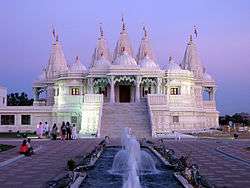 | |
| Name | |
| Proper name | BAPS Shri Swaminarayan Mandir |
| Geography | |
| Country | Canada |
| Province | Ontario |
| District | Toronto |
| Location | 61 Claireville Drive |
| Culture | |
| Primary deity | Swaminarayan |
| Architecture | |
| Architectural styles | Shilpa Shastras |
| History and governance | |
| Date built | July 2007 (consecrated) |
| Creator | Pramukh Swami Maharaj / BAPS |
| Website | http://toronto.baps.org/ |
The BAPS Shri Swaminarayan mandir in Toronto, Ontario, Canada is a traditional Hindu place of worship that was built by the BAPS Swaminarayan Sanstha. The BAPS Swaminarayan Sanstha, which is headed by Pramukh Swami Maharaj, is a global spiritual organization within the Swaminarayan branch of Hinduism. The mandir was built in 18 months and consists of 24,000 pieces of hand-carved Italian carrara marble, Turkish limestone and Indian pink stone.[1] The mandir is the largest of its kind in Canada and was constructed according to guidelines outlined in ancient Hindu scriptures.[2] The grounds spread over 18 acres and in addition to the mandir, include a haveli and the Heritage Museum.[3] The mandir is open daily to visitors and for worship. In July 2017, the temple will complete its 10 years of greatness, and spirituality.
Mandir and daily rituals
The temple is a type of ‘Shikarbaddha’ mandir, built according to principles laid out in the Shilpa Shastras, Hindu texts prescribing standards of sacred architecture.[4] Within the mandir, murtis (sacred images of the deities) have been installed in different shrines. The central shrine holds the murti of Swaminarayan, with Gunatitanand Swami to his left, together worshipped as Akshar-Purushottam Maharaj. Similarly, different shrines hold murtis of other Hindu deities such as Radha Krishna, Shiva Parvati, Sita Ram, Hanuman, Ganapati and the lineage of BAPS gurus who are Swaminarayan’s spiritual successors.[5]
Once the divine has been invoked in a murti, it becomes an embodiment of the Divine.[6] Accordingly, Swaminarayan sadhus (Hindu monks) offer devotional worship to the deities throughout the day. Before dawn, they awaken the deities by singing morning hymns (prabhatiya). The deities are then bathed and offered food and garments depending on the time of the day and season.[7] Food that has been offered to the deities is considered sanctified. These holy offerings are distributed to the devotees as prasadam.[7] Throughout the day, aarti, a ritual where devotees sing the glory of Swaminarayan while a lighted wick is circulated before the murtis, is performed five times a day and named mangala aarti, shanagar aarti, rajabhoga aarti, sandhya aarti and shayana aarti, respectively. During midday, lunch is offered. In the evening, dinner is offered. Finally, the sadhus put the murtis to rest by adorning them with night garments.[7]
Haveli
The mandir’s cultural center is referred to as the haveli because of its traditional Indian architectural style.[8] The haveli is defined by an intricately carved wooden façade. Inside the haveli is a courtyard surrounded by teak and rosewood columns. The columns are characterized by motifs ranging from mythological stories, the sun and moon, and animals such as peacocks and elephants.[9] The cultural center serves various functions. The assembly hall provides space for weekly congregations. Classrooms are used for youth cultural, religious and educational activities, which include music lessons, Hindu scripture classes and career development seminars. A full-size gymnasium is used for youth sports activities and dining after Sunday evening assemblies. A food shop provides visitors and members with an assortment of vegetarian snacks. There is a living quarters for the sadhus who perform daily rituals in the mandir.[3]
Heritage Museum
The Heritage Museum houses the Understanding Hindu Dharma Exhibition, which aims to provide visitors with a foundation of the key tenets of Hinduism.[10] It walks visitors through a culture and faith with origins in antiquity, beginning with an explanation of the origins of Hinduism and continuing to an explanation of the role of Hinduism today. It also showcases the role that Indo-Canadians have played in developments in the fields of art, architecture, science, democracy, education, culture, pluralism and spiritual values.[10]
Construction
On 23 July 2000, in the presence of Pramukh Swami Maharaj, devotees performed the shilanyas, or first stone-laying, ceremony on the future site of the Toronto shikarbaddh mandir.[11] Construction continued in various phases, beginning with the haveli and culminating in the opening on the shikharbaddh mandir. The haveli was officially opened on 18 July 2004.[3] At that time, the congregation held a Vishvashanti Mahayagna for world peace and family unity. Community leaders and representatives of various faith-based organizations were present for the event.[12]
Before the haveli was built, the congregation held weekly assemblies at a hari mandir in Etobicoke, Toronto.
The final phase of construction was completed in 2007. The official opening of the mandir was held on 22 July 2007 in the presence of Pramukh Swami Maharaj. Then-Prime Minister of Canada Stephen Harper, then-Premier of Ontario Dalton McGuinty and then-Mayor of Toronto David Miller, were in attendance at the opening.[13]
The opening of the mandir was the culminating event in a three-day festival. The festival included a nagar yatra, or parade of the deities and devotees, through Toronto that displayed traditional Indian folk dances and music, in addition to a ceremony that brought together devotees to pray for world peace.
Construction of the complex benefited largely from donations and volunteer efforts. This service is viewed by contributing members as a form of devotion. BAPS devotees believe that seva, or “selfless service,” can be offered physically, monetarily or through prayer. Seva is understood by devotees to be service volunteered to the community while holding God in remembrance.[14]
Community involvement and fundraising
Annual gala
The BAPS Swaminarayan Mandir of Toronto holds a gala each year to raise awareness, funds and support for various charities. Past beneficiaries include the Canadian National Institute for the Blind, the Heart and Stroke Foundation and charities that supported rebuilding efforts in light of natural disasters that occurred in Haiti and Japan.[15]
Walkathons
Alongside BAPS centres throughout North America, the BAPS mandir in Toronto holds an annual walkathon in support of various charities. Participants work to raise funds for BAPS Charities initiatives and local beneficiaries. In 2010, BAPS Charities Canada announced a pledge of $100,000 over five years for the SickKids Research and Learning Tower in Toronto.[16]
International Women’s Day celebrations
The mandir hosts an annual conference in March in support of International Women’s Day. Members of the community gather for the conference, to share ideas for the positive development of future generations of women. On 30 March 2013, the 6th annual conference was held. The theme was “Timeless Traditions: Celebrate the Past and Cultivate the Future”. The conference focused on understanding and communicating the glory of Hindu traditions and preserving them in order to help nurture future generations.[17]
In 2011, the conference was themed, “Honoring the Past, Envisioning the Future.” The program highlighted the role of women in India’s history and the present opportunities and challenges that face females in the Indian diaspora. The conference also commemorated the 100th anniversary of International Women’s Day.[18]
In 2010, the conference, themed “Nurturing Families, Shaping Communities”, aimed to highlight the fundamental role women play in shaping Canada. The Honorable Diane Finley, Minister of Human Resources and Skills Development, spoke about Canadian Government initiatives that support women and their families.[19]
Health fairs and lectures
BAPS Charities organizes an annual health fair and related lectures throughout the year. BAPS Charities (formerly BAPS Care International) is a humanitarian service organization that originated from BAPS with a focus on serving society.[20] These events are free and open to the public and promote early detection and prevention techniques to support the wellness of communities. The 7th annual Health Fair was held on 14 October 2012. Various community organizations such as the Ontario Dental Association, Sick Kids Foundation, William Osler Health System, the Heart and Stroke Foundation, South Asian Diabetes Association and the Alzheimer’s Association contributed to the event.[21]
Doors Open Toronto
From 2005 to 2009, the mandir participated in the annually held event, Doors Open Toronto.[22] This two-day event is intended to allow the public an opportunity to visit and learn about architecturally, historically, culturally and socially significant buildings in Toronto. There are over 100 such buildings on display annually. During the period in which the mandir participated, volunteers provided guided tours throughout the mandir and museum.[23]
Gallery
-

-

-

-
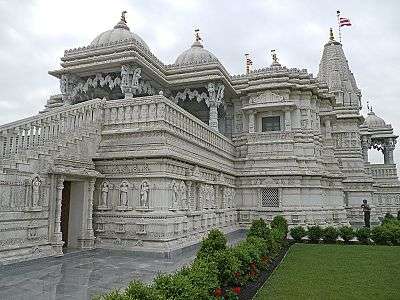
-
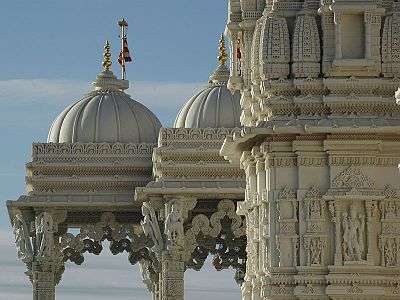
-
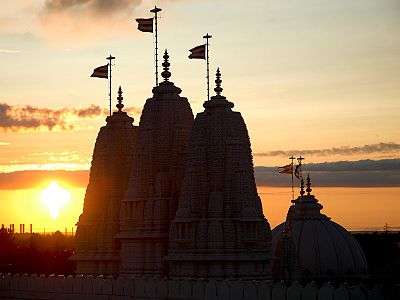
-
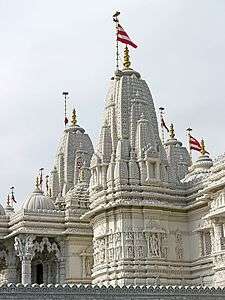
-
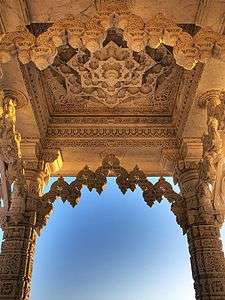
-

-

-

-
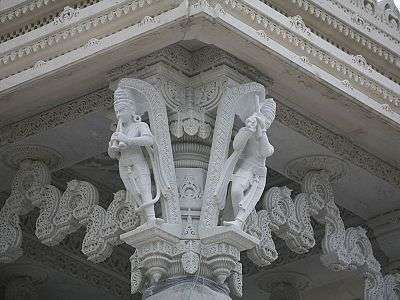
-

-

-
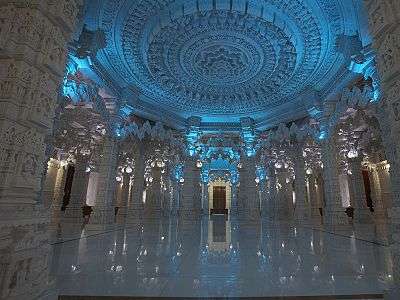
-

-
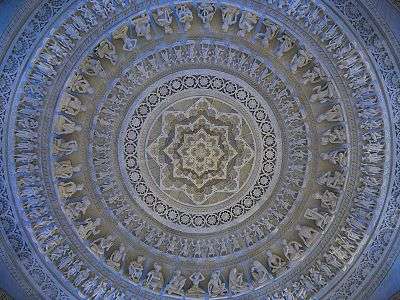
-
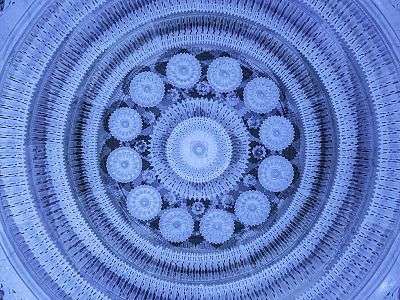
-

Bhagwan Swaminarayan and Gunatitanand Swami
-

Neelkanth Varni/Swaminarayan
References
- ↑ Dobrota, Alex (3 April 2009). "Canadian Hindu temple weaves itself into Toronto's tapestry". The Globe and Mail. Retrieved 5 May 2013.
- ↑ "Monument to Diversity". The Toronto Star. 24 July 2007. Retrieved 15 May 2013.
- 1 2 3 "Something One has to Experience". National Post. 2007. Retrieved 10 May 2013.
- ↑ Mukundcharan Das, Sadhu (2005). Hindu Rites and Rituals. Ahemadabad, India: Swaminarayan Aksharpith. p. 7. ISBN 81-7526-356-3.
- ↑ Hanna, Kim (2001). Being Swaminarayan: The Ontology and Significance of Belief in the Construction of a Gujarati Diaspora. Columbia University Press. pp. 347–349.
- ↑ Kumar Singh, Nagendra. Encyclopaedia of Hinduism. ISBN 8174881689.
- 1 2 3 Brady Williams, Raymond (8 Jan 2001). An Introduction to Swaminarayan Hinduism. Cambridge Press. ISBN 978-0521654227.
- ↑ Das, Usha (8 Feb 2013). "BAPS Toronto". News - East West. Retrieved 10 May 2013.
- ↑ Bhandari, Arpita (17 March 2009). "Marble and Teak Temple Hides Elephants and Peacocks". The Globe and Mail. Retrieved 8 May 2013.
- 1 2 "Heritage Museum". Ontario Heritage Connection. April 2009.
- ↑ BAPS. "BAPS Toronto Shilanyas". Retrieved 2 May 2013.
- ↑ BAPS (17 July 2004). "Vishwashanti Mahayagna". Retrieved 8 May 2013.
- ↑ Porter, Catherine (23 July 2007). "Thousands drawn to temple's dazzle". The Toronto Star. Retrieved 15 May 2013.
- ↑ Hanna, Kim (2001). Being Swaminarayan: The Ontology and Significance of Belief in the Construction of a Gujarati Diaspora. Columbia University Press. p. 85.
- ↑ "BAPS Charities". 12 May 2011. Retrieved 6 May 2013.
- ↑ "BAPS Charities Pledges $100,000 for Sick Kids Foundation". The Weekly Times of India. 24 September 2010.
- ↑ "BAPS On Women". The Weekly Voice. April 2013. Retrieved 24 May 2013.
- ↑ "Conference Celebrates 100 Years of International Women's Day". Weekly Voice. 2 May 2011.
- ↑ "Canada Highlights The Fundamental Role Women Play In Shaping The Country". The Gov Monitor. 12 March 2010.
- ↑ Clarke, Matthew (2011). Development and Religion: Theology and Practice. Northampton, MA: Edward Elgar Publishing. pp. 40–41. ISBN 978 1 84844 584 0.
- ↑ "BAPS Charities Health Fair In Toronto". The Weekly Voice. October 2012.
- ↑ "Archive Doors Open Toronto". 2009. Archived from the original on 28 May 2013. Retrieved 2 May 2013.
- ↑ "Doors Open Wins Again". 2008. Retrieved 1 May 2013.
External links
| Wikimedia Commons has media related to BAPS Shri Swaminarayan Mandir Toronto. |
- Organization information
- Mandirs and monuments
- Swaminarayan Akshardham, New Delhi
- Swaminarayan Akshardham, Gandhinagar Gujarat
- BAPS Shri Swaminarayan Mandir, London
- Shri Swaminarayan Mandir Houston
- Shri Swaminarayan Mandir Chicago
- BAPS Shri Swaminarayan Sanstha Chino Hills, California
- BAPS Shri Swaminarayan Mandir, Toronto Canada
